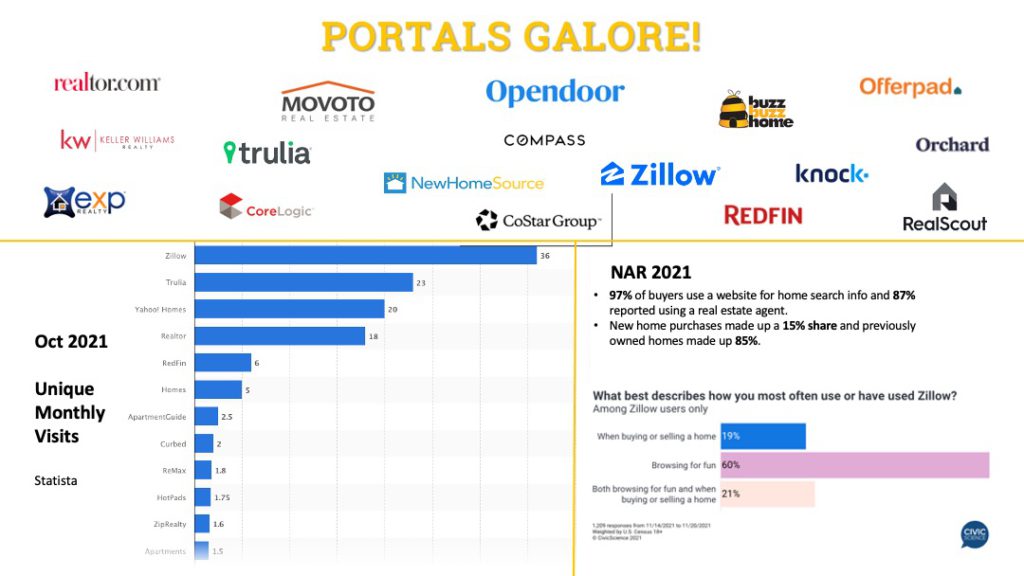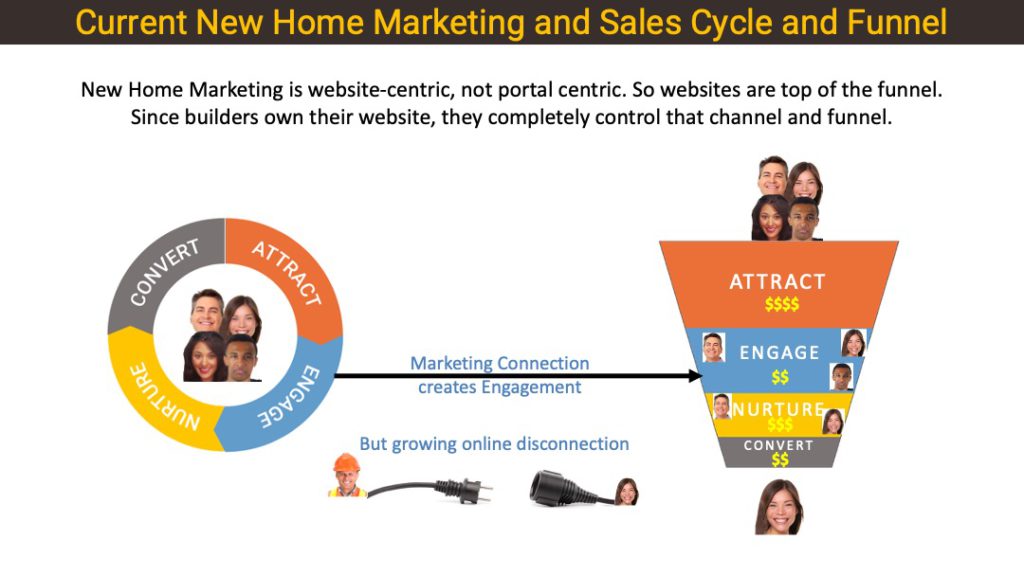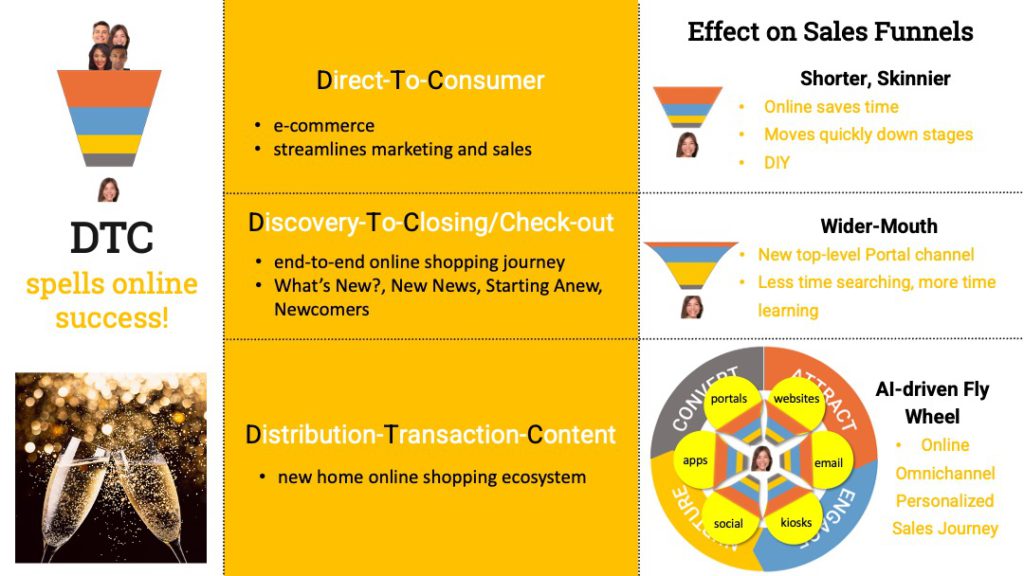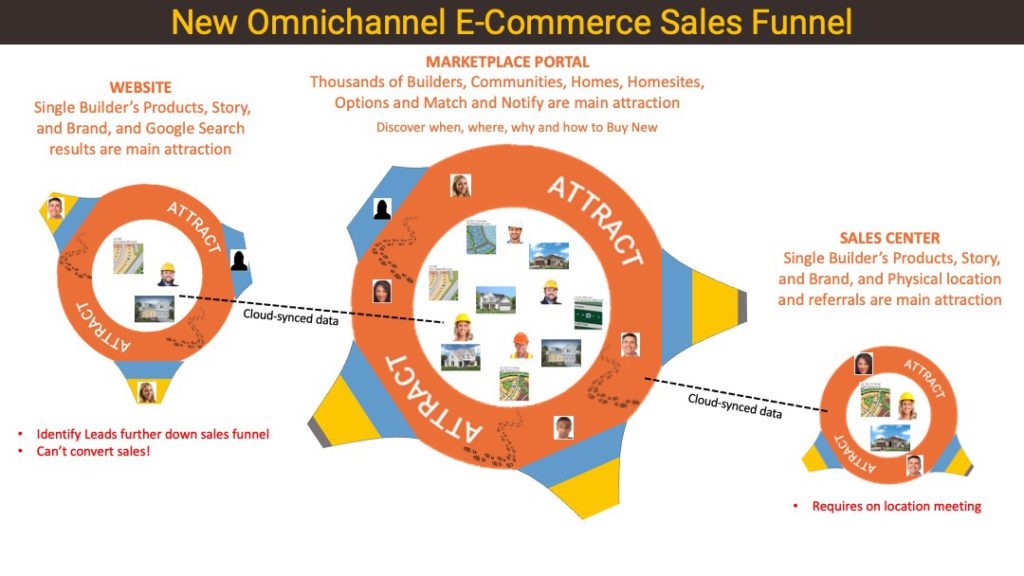A New Go of New Home Sales!
with John and Anya
Episode 9, February 15, 2022
The Shape of Things to Come: Transitioning from Old to New Sales Funnels
In an online omnichannel world, is taking shoppers offline a total disconnect? See how new e-commerce channels have completely re-shaped and turned the simple triangular sales funnel upside-down. There’s a simple solution: give “to each, his own” online shopping journey.
A lot has changed as more and more home buyers are going online to shop for their next home, including the customer journey and the shape of the sales funnel. So let’s take it from the top-the mouth of the funnel as that’s really where you attract the audience.
In the last ten years, we’ve had an explosion of portals. But most of these portals are geared toward used existing homes. Zillow is the main attraction. What’s interesting is that only nineteen percent of visitors come there when they’re buying or selling a home. Sixty percent are coming there for fun, and about twenty one percent come for both fun and when buying or selling a home. So, a lot of people just come there because they enjoy looking at homes. It’s America’s favorite pass time that builders are missing-out on because new homes are even more exciting to look at.

Why don’t we hear much about coming in through a portal to shop for new homes? We don’t have an MLS (multiple listings system) that aggregates all new home listings and then refines that data and distributes it to all these portals. The existing home market has it easy because they have everything very compartmentalized. You’re selling the whole house with the lot as opposed to us selling pieces and parts. But consumers don’t understand all those reasons behind it. They just want one destination place where they can learn all about the homes that they’re interested in buying and they can search across all the options without the fear of missing-out on anything.
According to the National Association of Realtors (NAR) ninety seven percent of all home buyers use a website to search for a home and this number is growing. New home purchases made up about fifteen percent of all home buyers and a whopping eighty five percent purchased used. More people chose to buy new in 2021 compared to previous years, but it’s still a far cry from the two thirds of all home shoppers who are open to buying new when they first start their home search.
To understand how online shopping is changing the shape of a sales funnel, a bit of builder marketing evolution history first. Pre websites, builders used paper mediums to advertise their homes-brochures, mailers, billboards, etc. And then in the early 2000s, we crossed the digital divide and went online with websites-that’s our new online general store. At the beginning, websites naturally gravitated towards search engines as they direct traffic to the website-builders online store. Then with advancements of online shopping, social marketing grew, and that became the natural next step for marketers to engage prospects and social media complimented websites.
But now we’re starting to move to Web3 and the final online shopping evolution requires eCommerce capabilities and it converges marketing and sales functions online. This is going to become the breaking point for website platforms that are not using modern software applications because a single website channel does not reflect the way consumers shop the complex product that are new homes, over a long period of time across multiple channels.
Current builder websites were not built for online sales. They weren’t built for ability to personalize, price or purchase online. Unlike used homes (portal-centric marketing), new home sales is website-centric with builders controlling the content and the channel. In eCommerce, the power’s going to the people and that’s going to change everything.
The builders spend a lot of their money on attracting prospects to the top of the funnel (the website). Then they don’t spend as much on the engagement part that’s because they never thought that buyers would ever buy online. They thought the whole point was to attract them online and then take them offline, hand them off to a salesperson in a model home. So they kind of wrote-off steps two, three and four on the website. But they need to spend more time and money on the second step, which is engagement because engagement is where marketing succeeds, because that’s where we connect with buyers. If you don’t have engaging online experience, buyers become disconnected.

The traditional sales funnel looks so clean and simple but it’s not so. Load up as many leads at the top as possible and then your salespeople work through each one, which involves multiple handoffs along the way, lots of miscommunication, and a lot of friction points. Every time a customer encounters a friction point, they’re much more likely to turn around and buy a used home. If we accurately draw that sales funnel, it would look like Swiss cheese. There are so many leaks in that funnel that by time you get down to the one you want, you lost about ten gold nuggets along the way.
This is why we need a new home marketplace because in a marketplace you have the buyers and sellers coming together at an equal level. It’s not the salesperson driving the buyer down a funnel. There’s no one-directional funneling because for new home sales everything is virtual and it can operate 24/7 and it instantly brings both the buyer to the product and the product to the buyer online. So it’s bidirectional sales funnels. There are no physical handoffs and there’s no funneling because everything is matched.

Direct-to-consumer (DTC) spells online success and it covers three important facets of the whole customer journey, which is distribution, transactions and the content. All three of these DTC factors affects the shape of the sales funnel. The traditional upside down triangle V shape sales funnel is outdated. That was in the old days where basically you sent out all these mailers and brochures, and then people come walking down the door through one channel.
In a marketplace, as we see with Zillow people come there for fun, returning multiple times so what happens to the sales funnel is it makes the mouth of the sales funnel much, much wider, but shallower at the same time. You’re attracting people to a marketplace and because they’re being matched with builders they begin to engage with communities, plans, options, and all that. They shop across multiple channels (marketplace, your website, social or a model home), they want to be able to start where they left off. They want to see the content, their favorites. They want to be able to design or even buy from any one of these channels and to pick up where they left off.

So the whole marketing and sales cycle needs to apply to everyone of those channels. They all need to be data-synced together in the cloud at a personal level. This AI-driven flywheel, which is very complex, it combines a flywheel with a sales funnel and it’s AI driven because there’s no person that can physically or logically put all this together. And then also covers them 24/7 around every channel.
Any one channel will not replace others, but it takes a village. The idea that they’re only going to come in through a website to your sales center and that’s it-that doesn’t reflect the way everyone shops. They’re going to have different channels for different purposes for different times. So your website, may focus on that single builder product story, and brand. You may still use Google search to attract people there. The problem with a website though, is you don’t get to identify who that lead is until they’re very far down the sales funnel. So you get a lot of traffic, but it’s all third party anonymous data. You don’t see individuals and what they’re doing on your website. You don’t get personal engagement on a website. And through your website, at least right now, you can’t convert any of the sales.
This new marketplace will bring in a larger audience, but you’re well matched. So buyers don’t go through this screening, filtering process, full of leaks and gaps. As a seller, you see see real people, buyers see real products, and you can take it all the way through the sales funnel, to the transaction. You’ll still have your sales centers that really can bring it from online to an offline, just like you had in the past. So the consumer can choose to come in in-person, or to stay on line, or go back to in-person whenever they choose. But even when you’re offline in person, you really should stay online in terms of letting them pick-up where they had left-off. It’s like an E-folio that essentially follows them around from start to finish. So as a salesperson, you know exactly where they are, you don’t have to make them repeat everything because it’s all electronically documented.

The buyer also has a funnel. With eCommerce, the shopping power shifts from the seller to the buyer, and when that happens, they’re going to start to shop you based on matchmaking and customer experience. So what the buyer does, is really simple. They don’t do these repeated searches and researches every day. They set it and forget it with match and notify. And then when a builder gets notified of a match, you can now buy that lead at no risk at your choice. The seller gets to collect personal, online shopping data that can not only guide the DIY shopper, but they also gain 24/7 sales service at a fraction of the cost.
Consumers are there. The technology is there. The only thing that’s really holding us back is the builders are still the gatekeepers. Covid forced builders to open the gates and go online, because they would’ve lost sales otherwise. The question is-are they going to keep these gates open past Covid or are they going to shut themselves back into the dark ages?
PRESENTATION SLIDES
Email Me New Episodes
Join our private email list to receive reminders of new episode releases, exclusive content and market insights. Your contact information will not be shared with others and you can unsubscribe at any time.
We welcome everyone – whether you are a customer, competitor, partner or just interested in our New Homes industry. We hope that together, we can enlighten ourselves, strengthen our relationships, grow our industry and better service our customers.
Follow Anewgo on LinkedIn




